Change in surface free energy by UV ozone cleaning surface modification
Irradiating metals, glass, plastics, and other solids with short-wavelength UV light removes organic surface contaminants and generates functional groups such as OH, CHO, and COOH on the surface, thereby improving the wettability of the solid surface. For example, it is known that UV irradiation of a glass surface for 2 to 3 minutes lowers the contact angle of water to an angle as it nears single digits, and we measured the surface free energy using a contact angle meter to see how the energy state of the actual material surface changes.
Click here for more information, including the theory of surface free energy.
Measurement conditions and equipment used
| Measurement conditions | Room temperature | 26.5℃ |
| Humidity | 25.0% | |
| Equipment used | UV surface modification cleaning equipment | ASM1101N |
| Contact Angle Meter | B100 | |
| Surface modification treatment | UV irradiation lamp | 110W 1-lamp type Low-pressure mercury vapor lamp |
| Irradiation distance | 30mm | |
| Contact angle measurement conditions | Liquid drop volume | 1.0μL |
| Waiting time for stabilization after liquid drop | 2 seconds | |
| Measurement point | 5 points | |
| Computational theory | Owens and Wendt | |
| Probe solution | Water, Diiodomethane (Methylene iodide) |
Probe solution
| Dispersion force(d) | Hydrogen bond strength(h) | Surface free energy(mJ/m2) | |
|---|---|---|---|
| Water | 21.8 | 51.0 | 72.8 |
| Diiodomethane | 49.5 | 1.3 | 50.8 |
Measurement Results
Acrylic
| Irradiation time(sec) | 0 | 30 | 60 | 90 | 120 | 150 | 180 | 210 | 240 | 270 | 300 | |
| Contact angle(°) | Water | 64.26 | 62.93 | 55.20 | 55.23 | 51.91 | 49.21 | 39.26 | 32.34 | 28.91 | 26.48 | 29.76 |
| Diiodomethane | 35.59 | 34.89 | 35.57 | 36.75 | 35.48 | 35.30 | 36.38 | 34.90 | 35.75 | 35.72 | 35.61 | |
| Component | Dispersion force(d) | 35.96 | 36.07 | 34.47 | 33.90 | 34.02 | 33.71 | 31.92 | 31.87 | 31.16 | 30.98 | 31.30 |
| Hydrogen bond strength(h) | 11.49 | 12.18 | 17.37 | 17.61 | 19.61 | 21.44 | 28.62 | 32.63 | 34.92 | 36.25 | 34.38 | |
| Surface free energy(mJ/m2) | 47.45 | 48.25 | 51.84 | 51.51 | 53.63 | 55.15 | 60.54 | 64.50 | 66.08 | 67.23 | 65.68 | |
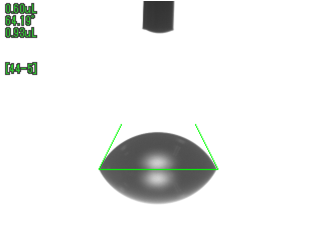

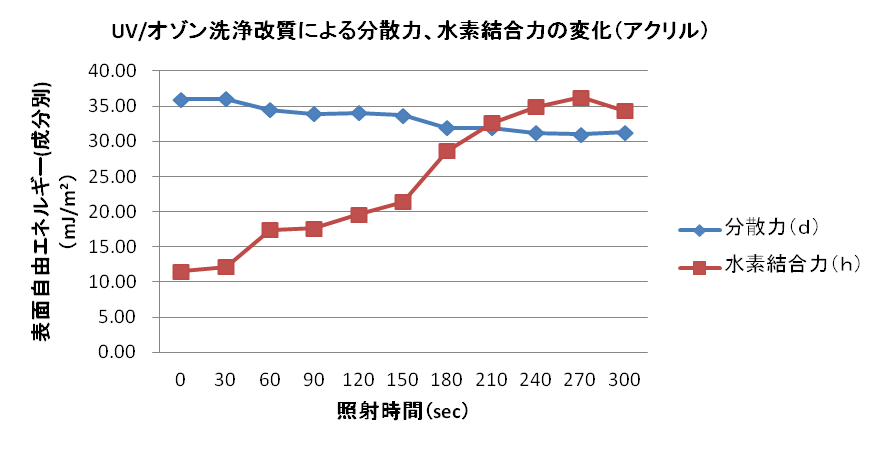
Polycarbonade
| Irradiation time(sec) | 0 | 30 | 60 | 90 | 120 | 150 | 180 | 210 | 240 | 270 | 300 | |
| Contact angle(°) | Water | 90.59 | 79.75 | 57.39 | 41.87 | 30.88 | 25.26 | 23.38 | 23.29 | 21.18 | 20.76 | 20.75 |
| Diiodomethane | 24.23 | 33.94 | 32.04 | 30.92 | 29.54 | 29.11 | 29.61 | 28.83 | 29.23 | 28.64 | 28.30 | |
| Component | Dispersion force(d) | 46.32 | 39.69 | 36.58 | 34.70 | 34.04 | 33.72 | 33.37 | 33.68 | 33.37 | 33.57 | 33.70 |
| Hydrogen bond strength(h) | 0.35 | 3.55 | 14.99 | 25.42 | 32.00 | 34.93 | 35.98 | 35.82 | 36.88 | 36.90 | 36.82 | |
| Surface free energy(mJ/m2) | 46.67 | 43.24 | 51.57 | 60.12 | 66.04 | 68.65 | 69.35 | 69.50 | 70.25 | 70.47 | 70.52 | |
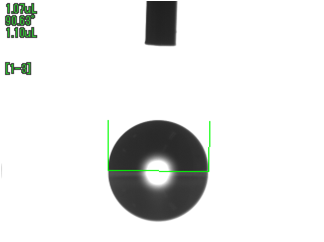
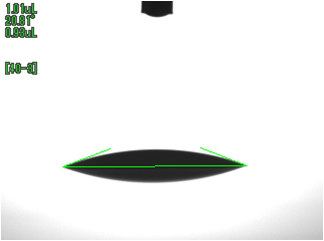
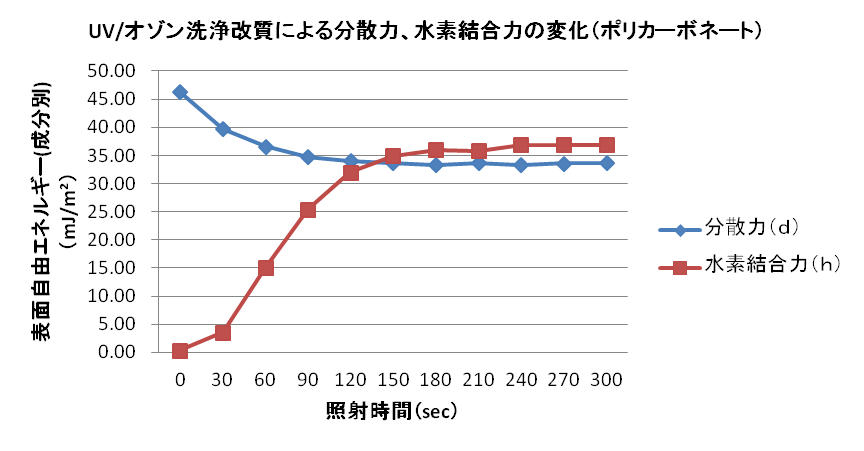
ABS
| Irradiation time(sec) | 0 | 30 | 60 | 90 | 120 | 150 | 180 | 210 | 240 | 270 | 300 | |
| Contact angle(°) | Water | 85.39 | 62.35 | 47.14 | 41.06 | 33.53 | 28.36 | 23.25 | 20.45 | 20.27 | 19.67 | 18.48 |
| Diiodomethane | 36.55 | 39.62 | 34.13 | 31.62 | 29.99 | 29.99 | 27.60 | 25.81 | 27.26 | 27.52 | 26.49 | |
| Component | Dispersion force(d) | 39.49 | 33.59 | 33.97 | 34.29 | 34.12 | 33.62 | 34.15 | 34.62 | 34.07 | 33.93 | 34.25 |
| Hydrogen bond strength(h) | 1.96 | 13.49 | 22.60 | 26.13 | 30.55 | 33.54 | 35.52 | 36.31 | 36.75 | 37.06 | 37.27 | |
| Surface free energy(mJ/m2) | 41.45 | 47.08 | 56.57 | 60.42 | 64.67 | 67.16 | 69.67 | 70.93 | 70.82 | 70.99 | 71.52 | |
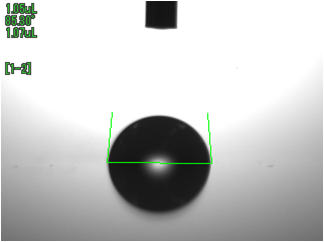
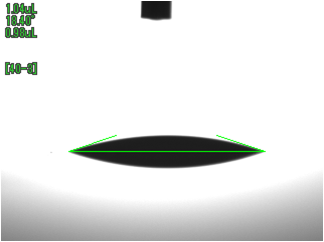
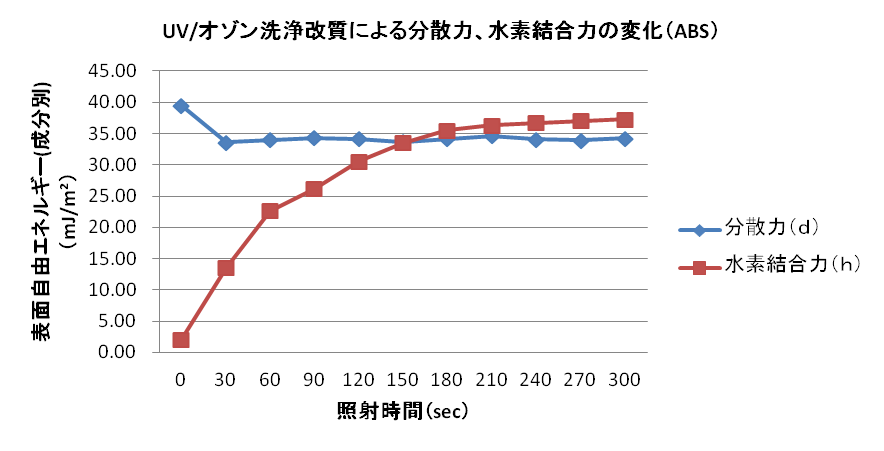
SUS304
| Irradiation time(sec) | 0 | 30 | 60 | 90 | 120 | 150 | 180 | 210 | 240 | 270 | 300 | |
| Contact angle(°) | Water | 70.67 | 59.60 | 54.91 | 36.49 | 29.23 | 23.07 | 24.67 | 23.83 | 31.07 | 20.93 | 23.14 |
| Diiodomethane | 45.90 | 42.67 | 33.57 | 35.28 | 33.76 | 37.05 | 33.69 | 35.08 | 34.64 | 36.89 | 35.21 | |
| Component | Dispersion force(d) | 31.57 | 31.54 | 35.37 | 32.12 | 32.09 | 30.11 | 31.75 | 31.06 | 31.87 | 30.04 | 30.96 |
| Hydrogen bond strength(h) | 9.68 | 16.04 | 17.13 | 30.13 | 34.12 | 38.43 | 36.54 | 37.40 | 33.32 | 39.37 | 37.78 | |
| Surface free energy(mJ/m2) | 41.25 | 47.58 | 52.50 | 62.25 | 66.21 | 68.54 | 68.29 | 68.46 | 65.19 | 69.41 | 68.74 | |
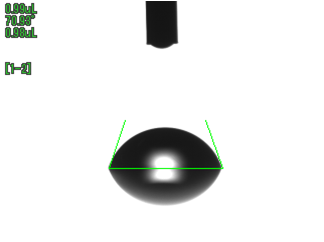
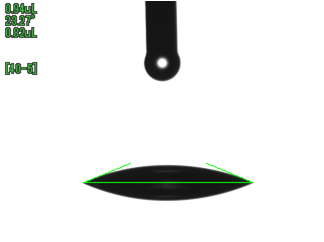
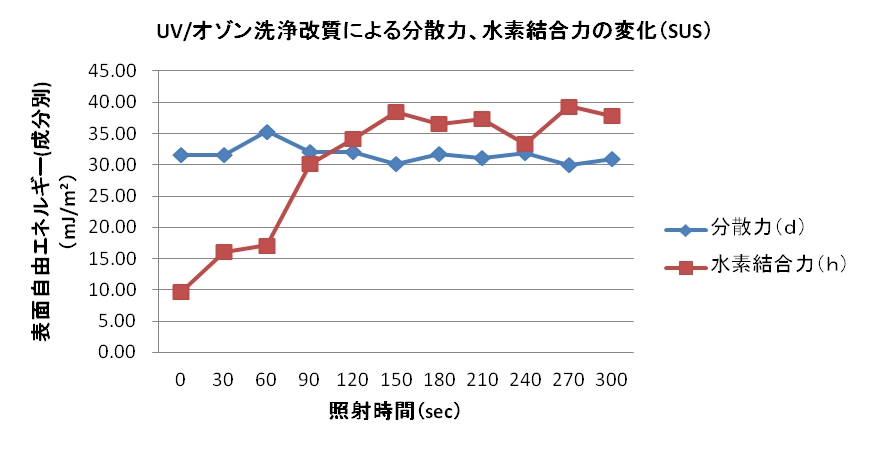
It can be seen that UV irradiation tends to lower the contact angle of water for both resins and metals. The graph below summarizes the change in surface free energy over the irradiation time.
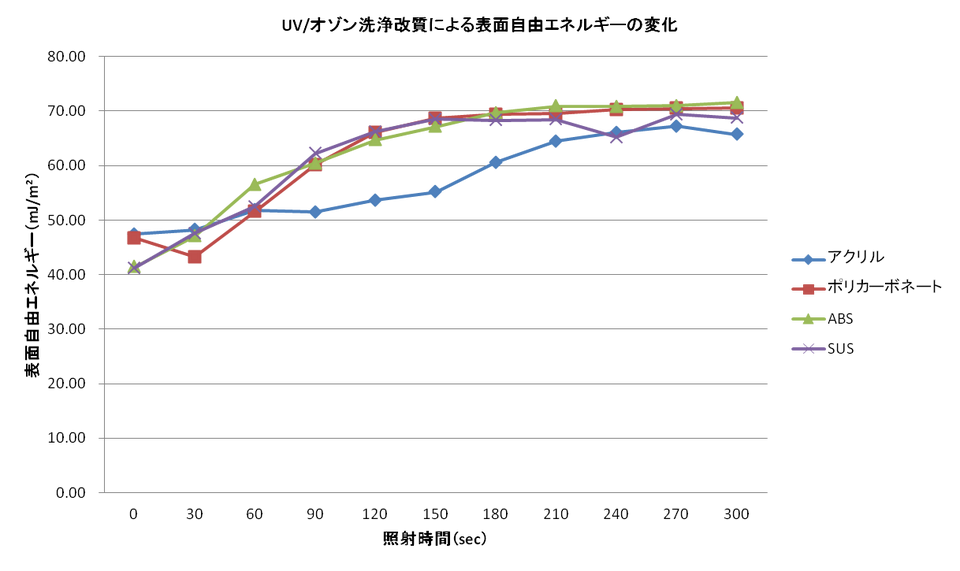
The hydrogen bonding strength of all materials tends to increase with time, suggesting that the functional groups have increased due to the surface modification effect of UV irradiation.
The results of the surface free energy calculation using Owen's theory show that the hydrogen bonding force of the surface free energy of both metals and resins increased dramatically due to the modification effect of the UV ozone cleaning modification, thereby the surface free energy of the solid approached the surface tension of water (72.8 mJ/m2 at 20°C), resulting in more better with water and improved wettability with water.


